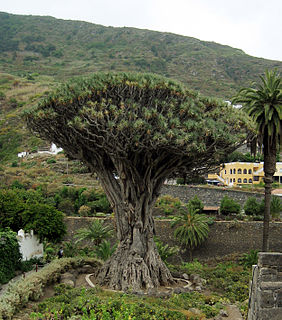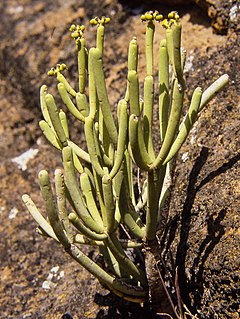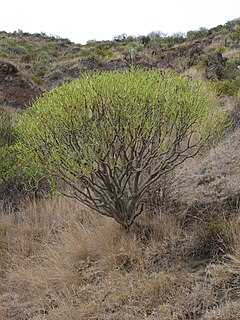
The Canary Islands, also known informally as the Canaries, are a Spanish region and archipelago in the Atlantic Ocean, in Macaronesia. At their closest point to the African mainland, they are 100 kilometres west of Morocco. They are the southernmost of the autonomous communities of Spain. The islands have a population of 2.15 million people and they are one of the outermost regions of the European Union.

Gran Canaria, also Grand Canary Island, is the third-largest and second-most-populous island of the Canary Islands, an archipelago off the Atlantic coast of Northwest Africa which is part of Spain. As of 2019 the island had a population of 851,231 that constitutes approximately 40% of the population of the archipelago. Las Palmas de Gran Canaria, the capital of the island, is the biggest city of the Canary Islands and the ninth of Spain.

Dracaena draco, the Canary Islands dragon tree or drago, is a subtropical tree in the genus Dracaena, native to the Canary Islands, Cape Verde, Madeira, western Morocco, and is thought to be introduced in the Azores. Its closest living relative is the dragon blood tree of Socotra, Dracaena cinnabari.

Gran Canaria Airport, sometimes also known as Gando Airport, is a passenger and freight airport on the island of Gran Canaria. It is an important airport within the Spanish air-transport network, as it holds the sixth position in terms of passengers, and fifth in terms of operations and cargo transported. It also ranks first of the Canary Islands in all three categories, although the island of Tenerife has higher passenger numbers overall if statistics from the two airports located on the island are combined.

Euphorbia atropurpurea, called tabaiba majorera or tabaiba roja in Spanish, is a shrub in the family Euphorbiaceae native to Tenerife in the Canary Islands. It can reach 2 metres in height, and grows in ravines, and on slopes and terraces.

Micromeria is a genus of flowering plants in the mint family, Lamiaceae, widespread across Europe, Asia, Africa, and North America, with a center of diversity in the Mediterranean region and the Canary Islands. It is sometimes placed within the genus Satureja. The name is derived from the Greek words μῑκρος (mīkros), meaning "small," and μερίς (meris), meaning "portion," referring to the leaves and flowers.
- Micromeria acropolitanaHalácsy - Greece
- Micromeria albanica(K.Malý) Šilic - Albania, Yugoslavia
- Micromeria × angosturaeP.Pérez Gran Canaria in the Canary Islands (M. tenuis subsp. linkii × M. varia subsp. canariensis)
- Micromeria arganietorum(Emb.) R.Morales - Morocco
- Micromeria benthamiiWebb & Berthel. - Gran Canaria in the Canary Islands
- Micromeria × benthamineolensSvent. - Gran Canaria in the Canary Islands (M. benthamii × M. pineolens)
- Micromeria biflora(Buch.-Ham. ex D.Don) Benth. - Himalayas from Afghanistan to Myanmar
- Micromeria × bourlieriMaire & Le Lièvre - Algeria, Morocco (M. graeca × M. inodora)
- Micromeria brivesiiBatt. - Morocco
- Micromeria × broussonetiiA.Santos, A.Acev.-Rodr. & Reyes-Bet. - Canary Islands (M. densiflora × M. varia)
- Micromeria browicziiZiel. & Kit Tan - Greece
- Micromeria chionistraeMeikle - Cyprus
- Micromeria conferta(Coss. & Daveau) Stefani - Libya
- Micromeria × confusaG.Kunkel & P.Pérez - Gran Canaria in the Canary Islands (M. benthamii × M. lanata)
- Micromeria cremnophilaBoiss. & Heldr. - Albania, Greece, Turkey, Syria, Lebanon
- Micromeria cristata(Hampe) Griseb. - Albania, Greece, Yugoslavia, Turkey, Bulgaria, Iran, Cyprus
- Micromeria croatica(Pers.) Schott - Albania, Yugoslavia
- Micromeria cymuligeraBoiss. & Hausskn. - Turkey
- Micromeria danaensisDanin - Jordan
- Micromeria debilisPomel - Algeria, Morocco
- Micromeria densifloraBenth. - Tenerife in the Canary Islands
- Micromeria ellipticaK.Koch - Turkey
- Micromeria filiformis(Aiton) Benth. - Corsica, Sardinia, Balearic Islands
- Micromeria flacca(Nábelek) Hedge - Turkey, Iraq
- Micromeria flagellarisBaker - Madagascar
- Micromeria fontanesiiPomel - Algeria, Morocco
- Micromeria forbesiiBenth. - Cape Verde Islands
- Micromeria fruticosa(L.) Druce - Eastern Mediterranean
- Micromeria glomerataP.Pérez - Tenerife in the Canary Islands
- Micromeria graeca(L.) Benth. ex Rchb. - Mediterranean from Morocco + Portugal to Turkey
- Micromeria guichardii(Quézel & Zaffran) Brullo & Furnari - Libya
- Micromeria hedgeiRech.f. - Iran
- Micromeria helianthemifoliaWebb & Berthel. - Gran Canaria in the Canary Islands
- Micromeria herpyllomorphaWebb & Berthel. - La Palma in the Canary Islands
- Micromeria hispidaBoiss. & Heldr. ex Benth. - Crete
- Micromeria hochreutineri(Briq.) Maire - Algeria, Morocco
- Micromeria × hybridaZagan - Greece including Crete (M. graeca × M. nervosa)
- Micromeria hyssopifoliaWebb & Berthel. - Tenerife + El Hierro in the Canary Islands
- Micromeria imbricata (Forssk.)C.Chr. - Africa from Nigeria to Ethiopia to Transvaal, Arabian Peninsula
- Micromeria inodora(Desf.) Benth. - Algeria, Morocco, Tunisia, Spain including Balearic Islands
- Micromeria × intermediaG.Kunkel & P.Pérez - Gran Canaria in the Canary Islands (M. benthamii × M. helianthemifolia)
- Micromeria juliana(L.) Benth. ex Rchb. - Mediterranean
- Micromeria kerneriMurb. - Yugoslavia
- Micromeria lachnophyllaWebb & Berthel. - Tenerife in the Canary Islands
- Micromeria lanata(C.Sm. ex Link) Benth. - Gran Canaria in the Canary Islands
- Micromeria lasiophyllaWebb & Berthel. - Canary Islands
- Micromeria lepidaWebb & Berthel. La Gomera in the Canary Islands
- Micromeria leucanthaSvent. ex P.Pérez - Gran Canaria in the Canary Islands
- Micromeria longipedunculataBräuchler - Yugoslavia, Albania
- Micromeria macrosiphonCoss. - Morocco
- Micromeria madagascariensisBaker - Madagascar
- Micromeria marginata(Sm.) Chater - Alpes Maritimes in France, Liguria + Sardinia in Italy
- Micromeria × meteoricaHausskn. - Greece (M. cremnophila × M. juliana)
- Micromeria microphylla(d'Urv.) Benth. - Balearic Islands, Sicily, Malta, southern mainland Italy, Crete, Cyprus, Libya
- Micromeria monantha(Font Quer) R.Morales - Morocco
- Micromeria myrtifoliaBoiss. & Hohen. - from Greece to Iran
- Micromeria nervosa(Desf.) Benth. - Mediterranean from Algeria + Balearic Islands to Turkey
- Micromeria × nogalesiiG.Kunkel & P.Pérez - Gran Canaria in the Canary Islands
- Micromeria peltieri(Maire) R.Morales - Morocco
- Micromeria × perez-paziiG.Kunkel - Gran Canaria in the Canary Islands (M. benthamii × M. tenuis)
- Micromeria persicaBoiss. - Iran, Iraq, Turkey
- Micromeria pineolensSvent. - Gran Canaria in the Canary Islands
- Micromeria × preauxiiWebb & Berthel. - Gran Canaria in the Canary Islands (M. benthamii × M. varia subsp. canariensis)
- Micromeria pseudocroaticaŠilic - Yugoslavia
- Micromeria rivas-martineziiWildpret - Tenerife in the Canary Islands
- Micromeria serbalianaDanin & Hedge - Sinai
- Micromeria sinaicaBenth. - Sinai, Israel
- Micromeria sphacioticaBoiss. & Heldr. ex Benth.- Crete
- Micromeria sphaerophyllaBaker - Madagascar
- Micromeria suborbicularis(Alain) Borhidi - Cuba
- Micromeria × tagananensisP.Pérez - Tenerife in the Canary Islands (M. glomerata × M. varia)
- Micromeria teneriffae(Poir.) Benth. ex G.Don - Tenerife in the Canary Islands
- Micromeria tenuis(Link) Webb & Berthel. - Gran Canaria in the Canary Islands
- Micromeria unguentariaSchweinf. - Ethiopia
- Micromeria variaBenth. - Canary Islands, Madeira, Cape Verde Islands
- Micromeria weilleri(Maire) R.Morales - Morocco
- Micromeria × wildpretiiP.Pérez - Tenerife in the Canary Islands (M. rivas-martinezii × M. varia)

Hypericum canariense is a species of flowering plant in the family Hypericaceae known by the common name Canary Islands St. John's wort. It is the sole member of Hypericumsect. Webbia.
Tourism is an essential part of the economy of the Canary Islands, a Spanish archipelago located in the Atlantic Ocean, 100 kilometres west of Morocco. Seven main islands and six islets make up the Canary Islands. They had more than 9 million foreign incoming tourists in 2007. Tourists seeking sunshine and beaches first began to visit the Canaries in large numbers in the 1960s. The Canary Islands are a leading European tourist destination with very attractive natural and cultural resources.

Geranium reuteri, the giant geranium, is a species of flowering plant in the family Geraniaceae, native to the Canary Islands. It was known for many years under the name Geranium canariense. In Spanish, it is called pata de gallo.

Globularia salicina is a shrub native to the archipelago of Madeira and to the central and western Canary Islands.

Canarina canariensis is a species of flowering plant in the bellflower family Campanulaceae, commonly known as the Canary Island bellflower, and known locally as bicácaro.

Sonchus bornmuelleri, or Bornmueller's sow-thistle, is a plant endemic to the Canary Island of La Palma.

Phyllis nobla is a small, glabrous or pubescent subshrub in the family Rubiaceae.

Euphorbia aphylla is a species of flowering plant in the family Euphorbiaceae. It is native to the Canary Islands. It was first described in 1809.

Erysimum scoparium is a species of flowering plant in the family Brassicaceae, native to the Canary Islands. It is a shrubby species of wallflower with purplish flowers found at high altitudes.

Sonchus congestus is a species of flowering plant in the family Asteraceae. It is endemic to the Canary Islands.

Euphorbia lamarckii is a species of flowering plant in the family Euphorbiaceae, native to the western Canary Islands. It resembles Euphorbia regis-jubae, with which it has been confused. Both have been called Euphorbia obtusifolia.

Euphorbia regis-jubae is a species of flowering plant in the family Euphorbiaceae, native to the eastern Canary Islands, western Morocco, north-western Western Sahara. In Spanish, it is known as tabaiba morisca. It has often been confused with Euphorbia lamarckii.

Aeonium aureum is a species of flowering plant in the family Crassulaceae, native to the Canary Islands. It has very short stems, usually with several leaf rosettes. The grey-green leaves are tightly packed and fleshy. The bright yellow flowers are produced on leafy stems, and are up to 25 mm (1 in) across.

Habenaria tridactylites is a species of flowering plant in the family Orchidaceae, native to the Canary Islands. It was first described by John Lindley in 1835.



















